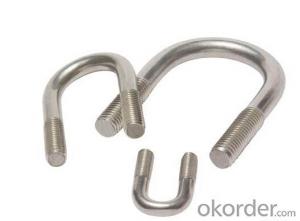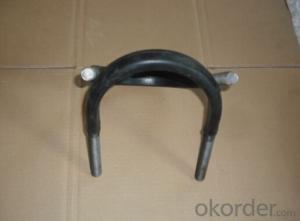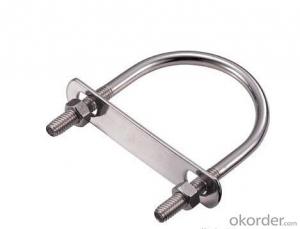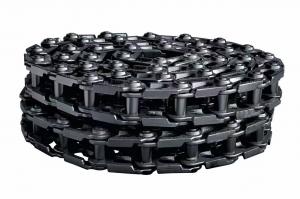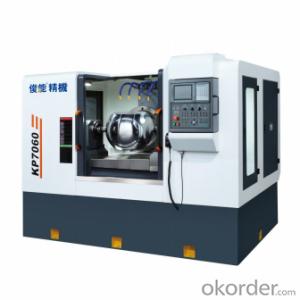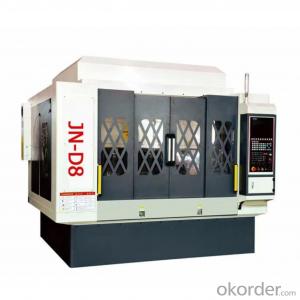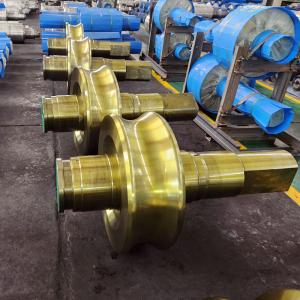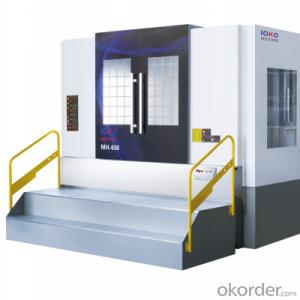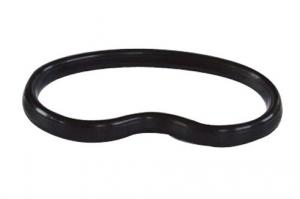U shape pipe clamp for Concrete Pump with high quanlity
- Loading Port:
- Shanghai
- Payment Terms:
- TT OR LC
- Min Order Qty:
- 10 set
- Supply Capability:
- 1000 set/month
OKorder Service Pledge
OKorder Financial Service
You Might Also Like
Concrete pump pipe clamp is applicable to concrete pump pipe.Its belongs to concrete pump spare parts
Specifications
stainless steel u bolt clamp steel pipe
1.Manufactur supply directly.
2.Size:M4-M48.etc
3.ISO,SGS.
4.Grade:201,304,316...
stainless steel u bolt clamp steel pipe
Size:stainless steel u-bolts
M6x16-50
M8x20-100
M10x20-100
M12x20-100
M14x30-100
M16x30-100
M18x40-100
M20x40-100
M22x50-100
M27x50-100
M30x50-100
M36x50-100
material:stainless steel
201
304 0Cr18Ni9 304L 00Cr19Ni10
321 0Cr18Ni9Ti 316 0Cr17Ni12Mo2
316L 00Cr17Ni14Mo2 310S 0Cr25Ni20
surface:bright
Tolerance: +/-0.015mm
Grade: 4.6 4.8 5.6 5.8 6.8,etc
DN125 Concrete Pump Clamp Coupling
Type-HD
| 1.5" clamp HD |
2" clamp HD |
| 3" clamp HD |
| 4" clamp HD |
| 3"clamp HD (adjustable) |
| 4"clamp HD (adjustable) |
| 2.5" clamp HD |
| 5" clamp HD |
| 5" clamp HD (adjustable) |
Type-Bolt& snap
Bolt Clamp 2" |
| Bolt Clamp 3" |
| Bolt Clamp 4" |
| Bolt Clamp 5" |
| Bolt Clamp 6" |
| Bolt Clamp Boom Bracket Type 5" |
| Two Bolts Boom Clamp 5" |
| Snap Clamp 2" |
| Snap Clamp 3" |
| Snap Clamp 4" |
| Snap Clamp 4.5" |
| Snap Clamp 5" |
| Snap Clamp 6" |
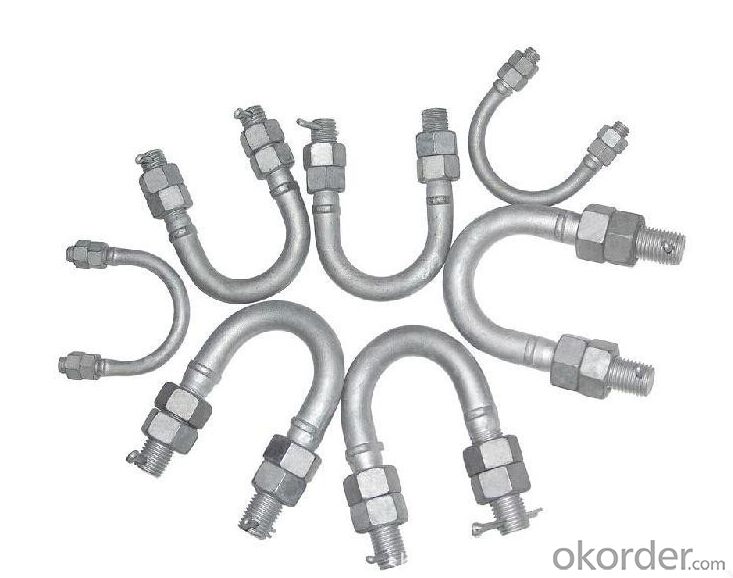
- Q:How often should hydraulic cylinders be inspected or replaced in a concrete pump?
- It is advisable to conduct regular inspections on hydraulic cylinders in a concrete pump, ideally every 500 hours of operation or at least once a year, whichever occurs first. However, it is important to acknowledge that the frequency of inspections may differ based on the specific conditions and usage of the concrete pump. During these inspections, qualified technicians should thoroughly assess the hydraulic cylinders for any indications of wear, damage, or leaks. Additionally, they should verify the alignment, piston rods, seals, and other components to ensure proper functionality. If any issues are discovered, such as excessive wear or leaks, it is recommended to promptly replace the hydraulic cylinders to prevent further damage and maintain optimal performance. The regular inspections and timely replacements of hydraulic cylinders are vital for guaranteeing the safety, efficiency, and longevity of a concrete pump. Neglecting proper maintenance can result in expensive repairs, decreased productivity, and even accidents. Therefore, it is crucial to adhere to the manufacturer's guidelines and seek advice from professionals to determine the appropriate intervals for inspecting and replacing hydraulic cylinders in a concrete pump.
- Q:How can a faulty electric motor affect the pump's performance?
- A faulty electric motor can significantly impact the pump's performance. It may cause the motor to run at a slower speed, leading to reduced pumping capacity and lower flow rates. Additionally, a faulty motor can result in increased power consumption, decreased efficiency, and overheating issues. In severe cases, the motor may completely fail, causing the pump to stop working altogether. Therefore, addressing any issues with the electric motor promptly is crucial to maintaining optimal pump performance.
- Q:What are the advantages of using genuine spare parts for my concrete pump?
- There are several advantages to using genuine spare parts for your concrete pump. Firstly, genuine parts are specifically designed and manufactured to fit and function perfectly with your pump, ensuring optimal performance and reliability. These parts are made with high-quality materials and undergo rigorous testing, providing durability and longevity. Secondly, using genuine spare parts helps to maintain the integrity and efficiency of your concrete pump. Non-genuine parts may not meet the same standards, leading to decreased performance, increased downtime, and potentially costly repairs. Genuine parts also come with warranties, providing peace of mind and assurance of their quality. Moreover, using genuine spare parts ensures compatibility with the rest of your equipment and reduces the risk of damage or malfunction. Mixing non-genuine parts with genuine ones can lead to mechanical issues, which can be avoided by sticking to genuine replacements. Lastly, using genuine spare parts helps to retain the value of your concrete pump. When it comes to selling or trading in your equipment, having genuine parts installed increases its market value, as it indicates that the pump has been properly maintained and cared for. Overall, investing in genuine spare parts for your concrete pump guarantees superior performance, longevity, compatibility, and value, making it a wise and cost-effective choice in the long run.
- Q:How can a malfunctioning control panel affect the pump's operation?
- A malfunctioning control panel can affect the pump's operation by causing errors in controlling the pump's speed, pressure, or flow rate. It can also lead to inaccurate monitoring of the pump's performance, failure to detect faults or abnormalities, and difficulty in troubleshooting issues. Ultimately, a malfunctioning control panel can compromise the pump's efficiency, reliability, and overall functionality.
- Q:How can a damaged concrete pump hopper affect the pumping process?
- The pumping process can be negatively impacted by a damaged concrete pump hopper in several ways. To begin with, efficiency and productivity can decrease when the hopper is damaged. The hopper's role is to hold and feed the concrete mixture into the pump. Any damage to the hopper can disrupt the continuous flow of concrete, leading to frequent interruptions in the pumping process. This causes delays and reduces the overall output of the pump. Furthermore, the quality of the concrete being pumped can be affected by a damaged hopper. The hopper is designed to ensure proper mixing and consistency of the concrete mixture before it is pumped. If the hopper is damaged, it may not effectively mix the concrete, resulting in inconsistencies in the mixture. This can lead to poor-quality concrete being pumped, compromising the structural integrity and durability of the final product. Additionally, a damaged hopper can pose safety risks for the workers involved in the pumping process. Sharp edges or loose parts on a damaged hopper can cause injury if not addressed properly. Moreover, if the hopper is not functioning correctly, it may cause clogs or blockages in the pump, leading to pressure build-up and potential accidents. Finally, maintenance and repair costs can increase due to a damaged hopper. An imperfect hopper may require frequent repairs or even replacement, which can be time-consuming and expensive. Regular maintenance and inspection of the hopper are crucial to identify any damages early on and prevent them from escalating into more significant issues. In conclusion, a damaged concrete pump hopper has significant implications for the pumping process, including reduced efficiency, compromised concrete quality, safety risks, and increased maintenance costs. Regular inspection, maintenance, and timely repairs are essential to ensure the smooth operation of the pump and the delivery of high-quality concrete.
- Q:What are the precautions for gas washing of concrete pump?
- During gas cleaning, the personnel shall not be close to the outlet of the discharge pipe, the pipe is turned sharply (if 90 bends) and the compressed air pipe is connected
- Q:Can concrete pump spare parts be recycled or disposed of responsibly?
- Yes, concrete pump spare parts can be recycled or disposed of responsibly. Many components of concrete pump spare parts, such as steel and rubber, can be recycled. These materials can be separated and processed for reuse in other industries. Additionally, responsible disposal methods, such as proper waste management systems, can be employed to ensure that any non-recyclable parts are disposed of in an environmentally friendly manner. Overall, efforts can be made to minimize the environmental impact associated with concrete pump spare parts by adopting recycling and responsible disposal practices.
- Q:What is the role of a concrete pump seal?
- The role of a concrete pump seal is to prevent leakage and maintain the pressure within the pumping system. Concrete pumps are used to transfer liquid concrete from one location to another, typically from a mixer truck to a construction site. These pumps operate under high pressure to ensure the concrete flows smoothly through the pipeline. A concrete pump seal is a vital component that helps maintain the integrity of the pumping system. It is usually made of durable materials such as rubber or polyurethane, designed to withstand the high pressures and abrasive nature of concrete. The seal is located at the connection points between various sections of the pipeline, including the pump, pipeline joints, and hose connections. The primary function of the seal is to prevent concrete from leaking out of the system. Concrete is a viscous material, and any leakage can cause significant problems, such as a decrease in pumping efficiency, wastage of concrete, and potential damage to the surrounding environment. The seal ensures that the pumping system remains leak-free, allowing for efficient and continuous concrete transfer. Additionally, the seal helps maintain the required pressure within the pumping system. Concrete pumps rely on consistent pressure to ensure the concrete is delivered smoothly and evenly. Any pressure loss due to leakage can lead to uneven flow or blockages in the pipeline, affecting the overall performance of the pump. By sealing the connection points, the seal helps maintain the desired pressure, ensuring the concrete is pumped efficiently. Overall, the role of a concrete pump seal is to prevent leakage, maintain pressure, and ensure the smooth and efficient transfer of concrete from the source to the destination. It is an essential component that contributes to the overall effectiveness and reliability of concrete pumping operations.
- Q:How can a faulty pressure gauge affect the concrete pumping process?
- A faulty pressure gauge can significantly impact the concrete pumping process in several ways. Firstly, it may provide inaccurate readings, leading to an incorrect assessment of the pressure within the system. This can result in either excessively high or low pressure being applied during the pumping process, which can lead to various issues. If the faulty pressure gauge displays a higher pressure than the actual value, it may cause over-pressurization of the concrete pump. This can lead to potential damage to the equipment, such as burst hoses or pipes, which can be dangerous for workers nearby. Additionally, excessive pressure can cause the concrete to be pumped too forcefully, potentially leading to the material splattering or leaking from the delivery system, resulting in wastage and an uneven distribution of the concrete. On the other hand, an incorrectly low pressure reading from the faulty gauge can have its own set of problems. Insufficient pressure within the pumping system can result in the concrete not being adequately delivered to the desired location. This can cause delays in the construction process and result in uneven or incomplete concrete placement, affecting the integrity and strength of the structure being built. Moreover, a faulty pressure gauge may also contribute to inaccurate monitoring of the concrete's slump or consistency. The pressure gauge is often used as an indicator of the concrete's flowability, and if the gauge is faulty, it may provide misleading information about the material's workability. This can result in the concrete mix being either too fluid or too stiff, leading to difficulties in pumping and potentially compromising the quality of the finished concrete structure. In conclusion, a faulty pressure gauge can have severe consequences on the concrete pumping process. It can lead to over-pressurization, material wastage, uneven distribution, delays in construction, and compromised concrete quality. Therefore, it is crucial to regularly inspect and maintain pressure gauges to ensure their accuracy and reliability, promoting safe and efficient concrete pumping operations.
- Q:What are the signs of a malfunctioning gearbox?
- A malfunctioning gearbox in a vehicle could be indicated by various signs. One of the most common signs to look out for is difficulty shifting gears. If you find that shifting gears smoothly is increasingly challenging or if you hear grinding or clunking noises during shifting, it might be an indication of a gearbox problem. Another sign that the gearbox is malfunctioning is when gears slip. This occurs when the selected gear fails to remain engaged and instead slips into a different gear, resulting in a loss of power or acceleration. Additionally, you might observe an increase in engine RPMs without a corresponding increase in speed. Leakage of transmission fluid is another indicator of a faulty gearbox. Transmission fluid plays a crucial role in lubricating and cooling the gears, so any leakage can lead to overheating and damage to the gearbox components. The presence of red or brown fluid underneath the vehicle could be a sign of a leaking gearbox. Unusual noises, such as whining, humming, or clunking sounds, can also point to gearbox issues. These noises may occur while driving, especially during acceleration or deceleration, and can be indicative of problems with the gears or bearings within the gearbox. Lastly, if you detect a burning smell emanating from the engine or gearbox area, it could be an indication of overheating or excessive friction within the gearbox. This can be caused by low or contaminated transmission fluid, worn-out gears, or a malfunctioning cooling system. In case you notice any of these signs, it is crucial to promptly have your vehicle inspected by a qualified mechanic. Ignoring gearbox issues can lead to further damage and potentially expensive repairs.
1. Manufacturer Overview |
|
|---|---|
| Location | |
| Year Established | |
| Annual Output Value | |
| Main Markets | |
| Company Certifications | |
2. Manufacturer Certificates |
|
|---|---|
| a) Certification Name | |
| Range | |
| Reference | |
| Validity Period | |
3. Manufacturer Capability |
|
|---|---|
| a)Trade Capacity | |
| Nearest Port | |
| Export Percentage | |
| No.of Employees in Trade Department | |
| Language Spoken: | |
| b)Factory Information | |
| Factory Size: | |
| No. of Production Lines | |
| Contract Manufacturing | |
| Product Price Range | |
Send your message to us
U shape pipe clamp for Concrete Pump with high quanlity
- Loading Port:
- Shanghai
- Payment Terms:
- TT OR LC
- Min Order Qty:
- 10 set
- Supply Capability:
- 1000 set/month
OKorder Service Pledge
OKorder Financial Service
Similar products
New products
Hot products
Related keywords
